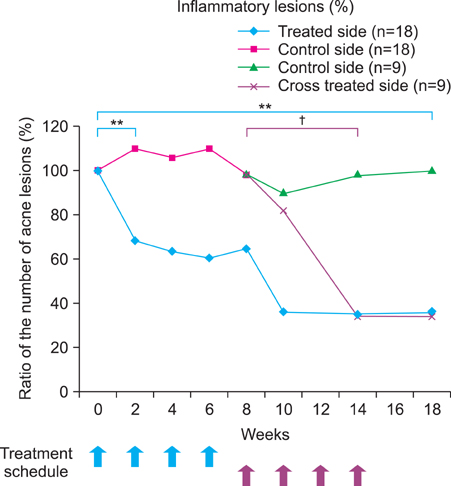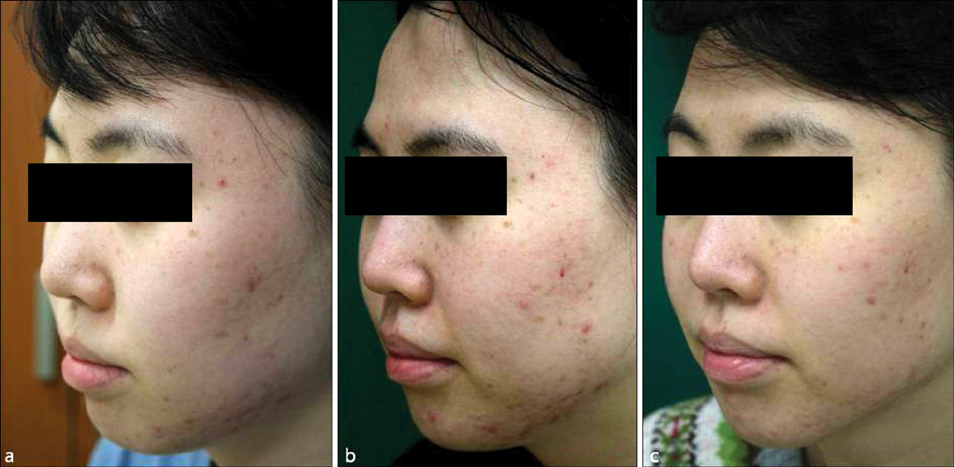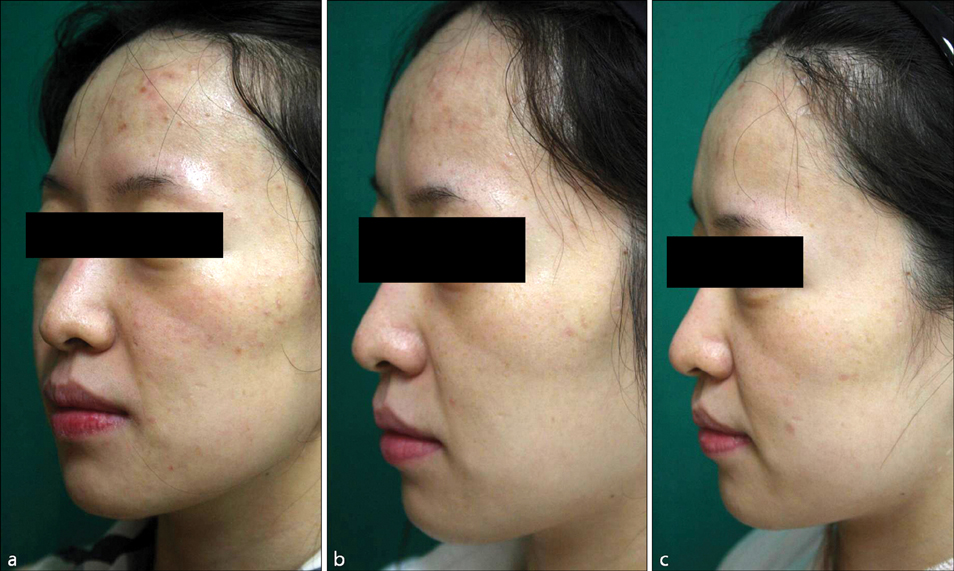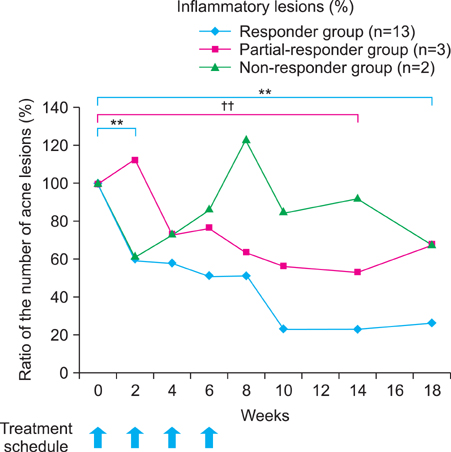Ann Dermatol.
2012 Aug;24(3):280-286. 10.5021/ad.2012.24.3.280.
An Open-Label, Split-Face Trial Evaluating Efficacy and Safty of Photopneumatic Therapy for the Treatment of Acne
- Affiliations
-
- 1Department of Dermatology, Kyung Hee University School of Medicine, Seoul, Korea. nikim@khmc.or.kr
- 2Arumdaun Nara Dermatologic Clinic, Seoul, Korea.
- KMID: 2265300
- DOI: http://doi.org/10.5021/ad.2012.24.3.280
Abstract
- BACKGROUND
Acne vulgaris is the most common skin disease worldwide, with many available treatment modalities, including oral and topical medications and laser therapy. Recently, a novel device (Isolaz, Pleasanton, CA, USA) that combines vacuum pressure and a broadband light source (400 nm to 1,200 nm) was developed for the treatment of acne.
OBJECTIVE
To determine the clinical efficacy and safety of photopneumatic therapy for the treatment of acne vulgaris of the face.
METHODS
Twenty adults with mild to moderate facial acne vulgaris received 4 successive treatments on one side of the face with a combined photopneumatic device (intense pulsed light: fluence=5.8 J/cm2; negative pressure=iMP mode) at 2 week intervals. Acne lesions on the opposite side of the face were not treated. Lesion counts were performed at baseline, prior to each treatment session, and at 3 months after the final treatment session.
RESULTS
Significant lesion improvements and reduced numbers of acne lesions were observed on the treated side of the faces. Most patients experienced global clinical improvement. No severe side effects occurred during the study, with only a few patients experiencing transient erythema, purpura and/or exacerbation of pre-existing acne.
CONCLUSION
Photopneumatic therapy is a safe and effective treatment for mild to moderate acne vulgaris.
Keyword
Figure
Reference
-
1. William DJ, Tomothy GB, Dirk ME. Andrews' diseases of the skin. 2006. 10th ed. Philadelphia: WB Saunders;231–239.2. Collier CN, Harper JC, Cafardi JA, Cantrell WC, Wang W, Foster KW, et al. The prevalence of acne in adults 20 years and older. J Am Acad Dermatol. 2008. 58:56–59.
Article3. Kawana S, Tachihara R, Kato T, Omi T. Effect of smooth pulsed light at 400 to 700 and 870 to 1,200 nm for acne vulgaris in Asian skin. Dermatol Surg. 2010. 36:52–57.
Article4. Shamban AT, Enokibori M, Narurkar V, Wilson D. Photopneumatic technology for the treatment of acne vulgaris. J Drugs Dermatol. 2008. 7:139–145.5. Wanitphakdeedecha R, Tanzi EL, Alster TS. Photopneumatic therapy for the treatment of acne. J Drugs Dermatol. 2009. 8:239–241.6. Munavalli GS, Weiss RA. Combination light therapies for the treatment of acne: An overview and introduction to photopneumatic therapy. Med Laser Appl. 2008. In press.
Article7. Sakamoto FH, Lopes JD, Anderson RR. Photodynamic therapy for acne vulgaris: a critical review from basics to clinical practice: part I. Acne vulgaris: when and why consider photodynamic therapy? J Am Acad Dermatol. 2010. 63:183–193.
Article8. Omi T, Munavalli GS, Kawana S, Sato S. Ultrastructural evidence for thermal injury to pilosebaceous units during the treatment of acne using photopneumatic (PPX) therapy. J Cosmet Laser Ther. 2008. 10:7–11.
Article9. Gold MH, Biron J. Efficacy of a novel combination of pneumatic energy and broadband light for the treatment of acne. J Drugs Dermatol. 2008. 7:639–642.
- Full Text Links
- Actions
-
Cited
- CITED
-
- Close
- Share
- Similar articles
-
- Combination of Fractional Microneedling Radiofrequency and Ablative Fractional Laser versus Ablative Fractional Laser Alone for Acne and Acne Scars
- Novel Photopneumatic Therapy for the Treatment of Rosacea
- The Role of Indocyanine Green and Diode Laser in the Treatment of Acne Vulgaris
- Clinical Trial to Evaluate the Efficacy and Safety of a Home-use Intense Pulsed Light Device for Hair Removal, Treatment of Acne and Pigmentation Disorders, and Fine Wrinkle Reduction
- Eight-Week Prospective Open-Label Trial of the Treatment Efficacy of Aripiprazole in Children with Tourette Syndrome







